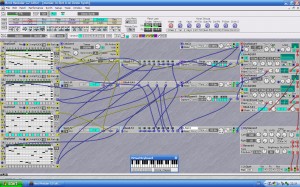Some time ago I described how the humble ARP sequencer could be used as an improvisational tool.
Well recently I’ve been rediscovering my Nord Modular which is an odd mixture of real and virtual. The synth is real enough and consists of a DSP based synth that is programmed from an editor running on a PC. The clever bit is that the synth works even when the PC editor is disconnected.
I originally got the Nord Modular to replace my ARP 2600 that I had owned for 16 years as I thought it would be more versatile and take up less space. It is, especially good is the way you can create modules as required, so if a patch needs four sequencers you just keep dragging extra sequencers onto the edit window until you have enough or you run out of DSP capacity.
Anyway I recently was reading about the Klee Sequencer that is based on a shift register and the ability to sum certain outputs from shift register as it runs. The summed outputs are then used to control the notes played by some VCOs, just like a normal sequencer.
Having read up on the sequencer and just before I fired up the soldering iron (my weapon of choice) I thought “I wonder if I can construct a virtual sequencer from some of the virtual logic modules”. The answer is, yes.
Actually it did rather a good job (results can be heard on www.myspace.com/normleete). Just to give you an idea what the patch looks like here is a recent patch that attempts to emulate the David Vorhaus sequencer called the MANIAC. Here is David’s own description from an old Sound on Sound interview:-
“One of the first things I built was an analogue sequencer called the Maniac that plays as fast as you like, has variable step lengths and can be configured to do things other sequencers of the time couldn’t do. If you used it linearly it worked as a 64-step, duophonic sequencer, but I also built in the ability to split it into several smaller groups, which gave it the potential for cybernetic serendipity. For example, I might set one group to run around a sequence of seven steps and another eight steps, then add and subtract the control voltage outputs. That’s the great thing about voltage control, you can just add and subtract, so I might have one sequence running octaves and fifths with the other running passing notes. That means it would run for seven times eight, or 56 steps before repeating. I could chromatically correct the output if I wanted to. Incidentally, the name is an acronym for Multiphasic ANalog Inter-Active Cromataphonic (sequencer).”

The Nord patch is in an early phase of development but can do a lot of these features and does some splendid sequences that evolve over many minutes. This is still an active line of enquiry and the soldering iron is still cold…